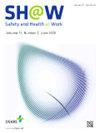Relationship Between Quality of Life and Occupational Health Literacy Among Informal Wood Furniture Workers in Thailand
IF 2.9
3区 医学
Q1 PUBLIC, ENVIRONMENTAL & OCCUPATIONAL HEALTH
引用次数: 0
Abstract
Background
Informal wood furniture workers face various occupational health and safety risks that may impact their health and quality of life (QOL). Improving health literacy (HL) could help mitigate these risks. This study aims to assess HL levels and their relationship to QOL among this group in Thailand.
Methods
This cross-sectional study was conducted in 2023 and involved 175 informal wood furniture workers employed in Ban Ma, Lamphun province, Thailand. Data collection instruments comprised the Occupational Health Literacy Questionnaire (TOHLS-IF) and a questionnaire assessing informal workers' QOL. Analysis encompassed descriptive statistics alongside partial correlation analysis (p < 0.05).
Results
Respondents demonstrated high overall health literacy (2.34 ± 0.45). Considering eight dimensions of QOL in the sample, some variables, such as insufficient income, debt, and underlying disease, were prevalent at high percentages and seemed to diminish workers' QOL. After adjustment for gender, age, level of education, and work experience, most QOL dimensions correlated positively with workers' HL levels (p < 0.05); significant variables included career goal setting (rs = 0.27, p < 0.001), conflicts in workplace (rs = 0.20, p = 0.009), environmental satisfaction (rs = 0.41, p < 0.001), readiness to use internet (rs = 0.28, p < 0.001) and applications (rs = 0.29, p < 0.001), coworker's respect (rs = 0.15, p = 0.003), and goal setting to advance career (rs = 0.28, p < 0.001). No significant relationship was observed between prevalent QOL-diminishing factors and health literacy.
Conclusion
The observed link between HL levels and multiple dimensions of QOL among informal wood furniture workers underscores the need for targeted interventions. Policymakers and social initiatives should focus on promoting health literacy and relevant skills to enhance QOL within this population.
泰国非正式木制家具工人生活质量与职业健康素养的关系
背景非正规木制家具工人面临各种职业健康和安全风险,可能影响他们的健康和生活质量(QOL)。提高卫生知识素养有助于减轻这些风险。本研究旨在评估HL水平及其与泰国人群生活质量的关系。方法本横断面研究于2023年进行,涉及175名在泰国兰埔省班马受雇的非正式木制家具工人。数据收集工具包括职业健康素养问卷(TOHLS-IF)和非正式工人生活质量评估问卷。分析包括描述性统计和偏相关分析(p <;0.05)。结果被调查者总体健康素养较高(2.34±0.45)。考虑到样本中生活质量的八个维度,一些变量,如收入不足、债务和潜在疾病,在很高的百分比中普遍存在,似乎降低了工人的生活质量。在调整性别、年龄、教育程度和工作经验后,大多数生活质量维度与员工的HL水平呈正相关(p <;0.05);显著变量包括职业目标设定(rs = 0.27, p <;0.001)、工作场所冲突(rs = 0.20, p = 0.009)、环境满意度(rs = 0.41, p <;0.001),使用互联网的准备程度(rs = 0.28, p <;0.001)和应用(rs = 0.29, p <;0.001)、同事的尊重(rs = 0.15, p = 0.003)和职业发展目标的设定(rs = 0.28, p <;0.001)。普遍的生活质量降低因素与健康素养之间无显著关系。结论非正式木制家具工人的HL水平与生活质量的多个维度之间存在联系,因此需要有针对性的干预。决策者和社会举措应侧重于促进卫生知识普及和相关技能,以提高这一人群的生活质量。
本文章由计算机程序翻译,如有差异,请以英文原文为准。
求助全文
约1分钟内获得全文
求助全文
来源期刊

Safety and Health at Work
Social Sciences-Safety Research
CiteScore
6.40
自引率
5.70%
发文量
1080
审稿时长
38 days
期刊介绍:
Safety and Health at Work (SH@W) is an international, peer-reviewed, interdisciplinary journal published quarterly in English beginning in 2010. The journal is aimed at providing grounds for the exchange of ideas and data developed through research experience in the broad field of occupational health and safety. Articles may deal with scientific research to improve workers'' health and safety by eliminating occupational accidents and diseases, pursuing a better working life, and creating a safe and comfortable working environment. The journal focuses primarily on original articles across the whole scope of occupational health and safety, but also welcomes up-to-date review papers and short communications and commentaries on urgent issues and case studies on unique epidemiological survey, methods of accident investigation, and analysis. High priority will be given to articles on occupational epidemiology, medicine, hygiene, toxicology, nursing and health services, work safety, ergonomics, work organization, engineering of safety (mechanical, electrical, chemical, and construction), safety management and policy, and studies related to economic evaluation and its social policy and organizational aspects. Its abbreviated title is Saf Health Work.
 求助内容:
求助内容: 应助结果提醒方式:
应助结果提醒方式:


